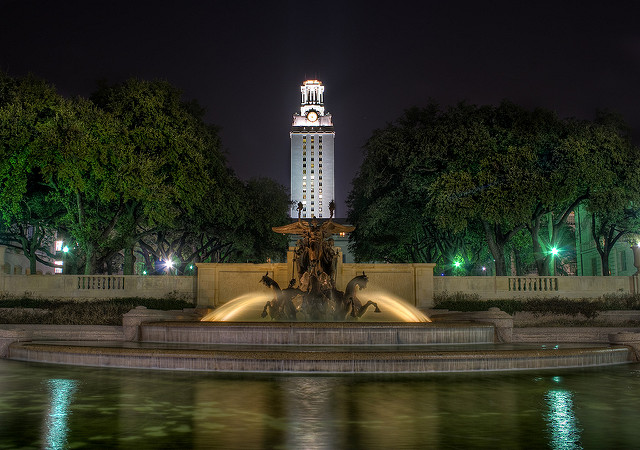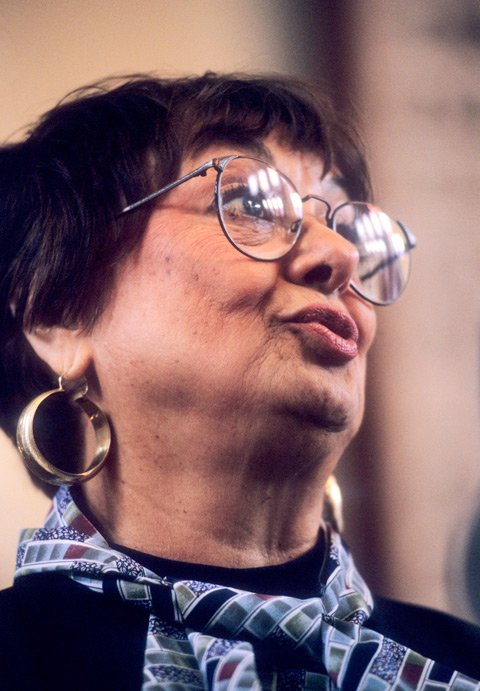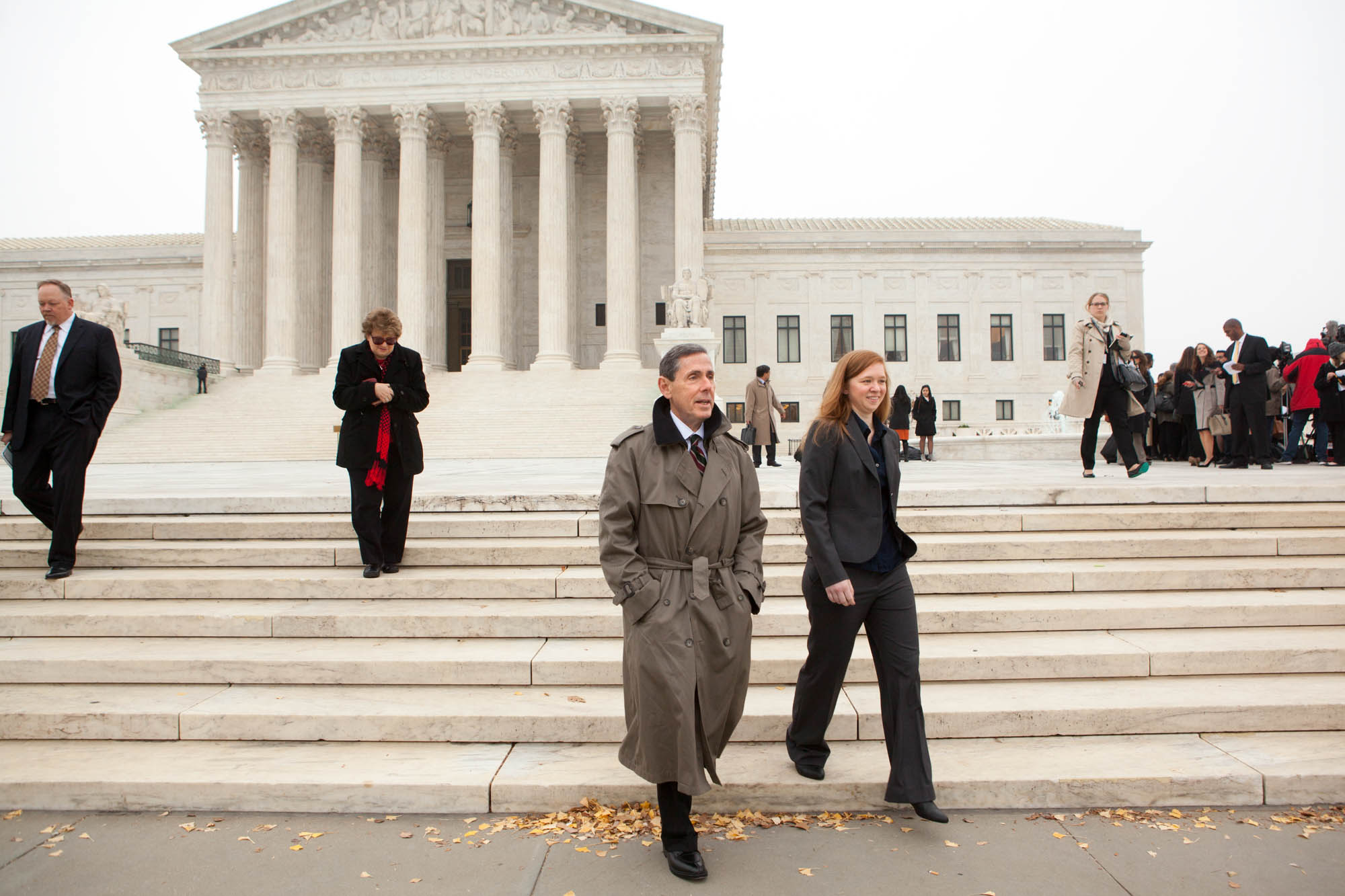How an Attempt to Boost Diversity at Texas Colleges Could Kill Affirmative Action

*Excellent story about the affirmative action lawsuit now before the U.S. Supreme Court. The case was heard in December and a ruling is expected by June. This is an outlier of sorts, given the death of Justice Antonin Scalia. Since Scalia’s passing, in all other cases a 4-4 tie means that the lower court ruling would stand, but Justice Elena Kagan has recused herself from this case, so there is no 4-4 possibility. Justice Kennedy seems to be the swing vote. VL
By Matthew Watkins and Neena Satija, The Texas Tribune (16 minute read)
On Dec. 9, a lawyer for Abigail Fisher stood before the U.S. Supreme Court ready to argue that the University of Texas at Austin was discriminating against white applicants.
He planned to make the case that his client was unfairly denied admission into the university because of her race. And affirmative action opponents hoped that Fisher v. University of Texas at Austin would bring an end to the use of race as a factor in college admissions.
But less than 90 seconds into his introduction, Fisher’s lawyer was interrupted by a question about Texas’ Top 10 Percent Rule. And for much of the next hour, the justices and attorneys argued over the intricacies of the state’s unusual college admissions law, which guarantees a spot in any state college to Texans who graduate near the top of their high school senior class.
It was in many ways the culmination of a long history of extraordinary twists when it comes to the Top 10 Percent Rule. Two decades ago, Hispanic activists and lawmakers conceived the policy as a way to get more minorities into the state’s top public universities. Now, it’s the focus of a legal strategy designed to kill affirmative action in Texas — or even nationwide.
But it’s no surprise that the rule has sparked an intense debate. It has been attacked from every political angle since it became law. Minority lawmakers have zealously defended it in the Texas Legislature every two years, while an impassioned group of mostly suburban lawmakers has fought to kill it.
At UT-Austin, the rule has been blamed in part for fueling an admissions scandal; causing a “brain drain” of would-be Longhorns to out-of-state schools; and hurting the school’s ranking, which is consistently lower than that of other top public universities. And the jury is still out about how much it has helped minorities.
The persistent controversy shows how there are no easy answers in the debate over race and higher education. The state has struggled to make its universities more diverse for decades. But Hispanics today make up fewer than a quarter of students at Texas’ flagship schools, UT-Austin and Texas A&M University, compared to nearly half of college-aged Texans statewide.
“You have to use whatever is available to make things balanced and fair,” said Gonzalo Barrientos, an Austin Democrat who shepherded the Top 10 Percent Rule through the state Senate. “If you are saying, ‘OK, everything is equal now and we don’t need it,’ then prove it. Show me a better way — a more balanced way, a more fair way — and I’m open.”
“The Talented Tenth”
In many ways, the current debate over the rule that has changed how a generation of Texans got into college can be traced back to two former UT-Austin students.
One of them is Barrientos. The other is Edward Blum, a former stockbroker who has devoted his time to filing lawsuits that aim to end the use of race in government decisionmaking.
Barrientos, who is Hispanic, grew up in the Central Texas town of Bastrop and spent the summers traveling with his family as a migrant farm worker. Blum attended high school in Houston and comes from a white, middle-class family.

Both arrived at UT-Austin during the height of the Civil Rights Movement, and both had a keen sense of racial injustice. Each noticed how few students of color were on campus and how segregated Austin was.
While in college, Barrientos got involved in community organizing. Blum protested at the president’s office, demanding that the university use racial quotas in admissions.
But their paths, and views, soon diverged. Barrientos, who grew up speaking Spanish at home, felt isolated among the white city kids, many of whom lived in lavish fraternity houses. He dropped out and later became an activist and community organizer for civil rights and anti-poverty groups. First elected to the Texas Legislature in 1974, he became a fierce affirmative action advocate.
Blum graduated from UT-Austin in 1973 and became a stockbroker. In his late 20s, he moved to a Houston suburb and lived across the street from a conservative political science professor. The two struck up a friendship that would change the way the former die-hard liberal thought about race and the Civil Rights Movement.[pullquote] [/pullquote]
In an interview, Blum said he realized “American civil rights ideals had evolved away from those original principles. And those original principles were that your race and your ethnicity should not be used to hurt you in life, nor should it be used to help you in life.”
Barrientos and Blum never met, but a series of lawsuits caused their lives’ work to become inextricably intertwined — starting with one filed by a white Californian named Cheryl Hopwood.
Hopwood, a top student at California State University, Sacramento, sued UT-Austin after the college’s law school rejected her application in 1992. She, along with several other plaintiffs, claimed it was unfair that minority students with lower test scores and grades were admitted. A federal appeals court agreed in 1996, ruling that she had been discriminated against because she was white.
The ruling unleashed a wave of panic among affirmative action advocates. The Supreme Court declined to hear Texas’ appeal. And state Attorney General Dan Morales declared that the ruling applied to all schools in Texas, which meant none of them could consider race in college admissions. UT-Austin President Robert Berdahl predicted the ruling would lead to “the virtual resegregation of higher education” in Texas.
Read more NewsTaco stories on Facebook >>
The idea of resegregation was chilling to Barrientos, whose childhood was a constant reminder of the effects of racial disparity in Texas. During road trips across the state to pick cotton with his family, he had been kicked out of restaurants and forced to use the bathroom in drainage culverts because the roadside stores didn’t allow Mexicans inside. In his hometown of Bastrop, it took a federal court order to allow him and his classmates into the whites-only elementary school.
“I started getting calls from Houston, North Texas, the Valley, West Texas, asking, ‘What are we going to do now?’” Barrientos recalled in an interview.
So he called a meeting in September 1996 at UT-Austin’s school of government to brainstorm. And it was there, before about 100 attendees, that a long-haired professor named David Montejano presented an idea. It was simple — so simple that Montejano joked that it was slipped under his office door.
Texas’ public school system was unequal, Montejano said. Students at wealthy, mostly white suburban schools were getting the best education and earning the highest test scores — and the vast majority of UT-Austin’s incoming freshmen came from those schools.
Poor students of color at underperforming high schools were left with little chance of getting in. But promising automatic admission to the same proportion of students from every school would level the playing field, he said.
Montejano said he thought he knew the right proportion: 10 percent. It was based on an old W.E.B. DuBois essay from 1903, which fought against the idea that blacks should focus on learning manual labor instead of the liberal arts. DuBois called for black colleges to educate the race’s best and brightest. Those elites — “The Talented Tenth,” as he called them — would lead blacks to prosperity.
“The Negro race, like all races, is going to be saved by its exceptional men,” DuBois wrote.
The activists were convinced. The next step was to win the Legislature’s approval. State Rep. Irma Rangel, a Kingsville Democrat widely known as a whip-smart dealmaker, took the reins from there.
“Race-neutral”
Rangel, who died in 2003, knew that if the bill were seen as a tool designed to help blacks and Hispanics at the expense of others, it would fail. Instead, the law needed to be portrayed as a populist measure that would help anyone who was disadvantaged.
She told the scruffy professors and activists to stay out of it. She’d get the bill passed herself when lawmakers reconvened in 1997.
“She would say, ‘Gentlemen, I need data and I need politics. You give me the data, and I’ll take care of the politics,’” said Michael Olivas, who helped devise the plan as a professor at the University of Houston.
At first, many conservative lawmakers thought the rule would be unfair to white students from good schools. But Rangel showed them that under the current system, rural white kids suffered just as much as urban black and Hispanic students. Some rural Texas counties, it turned out, had never sent a student to UT-Austin.

Slowly, a coalition of urban liberals and rural conservatives emerged. While there was still strong opposition from suburban lawmakers, Rangel used her deal-making leverage as a committee chairwoman to bring enough people along. Then, on the House floor, she proclaimed the bill’s fairness.
“With a favorable vote,” she told her colleagues, “we will give students the respect they deserve. We’re saying that the top 10 percent from each high school, from Plano, from Lubbock, not just from South Texas, will be able to go to the university of their choice.”
The bill narrowly passed, 77-68, in the House. Barrientos sponsored the Senate version, which was approved less than a month later. On May 20, 1997, then-Gov. George W. Bush signed it into law in the border town of Brownsville.
The impact was immediate. In 1998, the decline in minority students at UT-Austin halted. In 1999, black and Hispanic enrollment soared. The number of black students in the 1999 freshman class climbed by 44 percent, while the number of Hispanics jumped almost 10 percent.
Critics had feared that the Top 10 Percent Rule would allow unqualified and unprepared students into Texas universities. But the numbers showed that of the freshman entering UT-Austin in 1999, the Top 10 Percenters were actually performing better. Their freshman year GPA was 3.25, compared with 2.76 for the students admitted from outside the top 10 percent.
That told Barrientos he’d been right all along. The students of the poor, minority-dominated schools were just as talented as the rich suburban kids. Their enrollment wasn’t lower because of a lack of potential, he believed; it was the result of uneven high school resources and culturally biased tests.
But as time went on, new problems would surface, especially at UT-Austin. While fewer than half of the university’s freshmen were admitted automatically in 1998, the proportion had grown to 70 percent five years later. University officials, along with parents of students at competitive high schools, began to worry that there wouldn’t be room for anybody else.
Then in 2003, the Hopwood decision was nullified. The Supreme Court upheld the use of affirmative action in a case involving the University of Michigan. Texas universities were free to consider race again.
UT-Austin announced that day that it planned to begin using race as a factor when evaluating students who weren’t automatically admitted. Barrientos was thrilled. But Edward Blum was watching, too. And he started plotting a lawsuit of his own.
Finding Fisher
Blum wasn’t a lawyer, but by 2003 he had begun making an unpaid career out of filing lawsuits. The work was turning him into a hero among conservatives who believed policies like affirmative action constituted reverse discrimination.
His first lawsuit stemmed from a 1992 run for Congress in a diverse, Houston-area district. Running as a Republican with little money behind him, he lost by 32 percentage points. But he never had a chance. Texas lawmakers had drawn the district’s lines in a way that split neighborhoods apart in order to increase black representation in Congress. That bothered Blum, and he sued the state over its use of race.
“I had never sued anyone in my life, and no one had ever sued me, thank goodness,” said Blum, who found a lawyer to take the case for next to nothing. But remarkably, the lawsuit reached the U.S. Supreme Court. And even more remarkably, he won.
In a 5-4 decision handed down in June 1996, the justices struck down Texas’ congressional district lines. It was a victory for conservatives and paved the way for future cases that would seek to weaken the federal Voting Rights Act.
Blum said he almost immediately began receiving calls from others who felt they had been affected by reverse discrimination. He successfully helped a group of white parents sue to end the use of racial quotas in the Houston school district’s gifted and talented schools.
And in 2003, Blum set his sights on the college level. In the Supreme Court’s 5-4 decision that year in favor of the University of Michigan, the justices allowed colleges to use race in admissions — but only under strict guidelines. Blum felt confident that UT-Austin didn’t meet those guidelines.
To justify the consideration of race in admissions, schools must show a “compelling need” to increase diversity among their student bodies. And they have to explore whether there are “race-neutral” alternatives to achieve that goal. The Top 10 Percent Rule, Blum believed, was such an alternative and had proved to be more effective than affirmative action in growing diversity.
“I suspected that was a bridge too far,” Blum said of UT-Austin’s new policy. “It was because of that announcement that I began thinking about suing.”
Because he hadn’t been directly impacted by affirmative action, Blum couldn’t sue on his own. So he searched for a plaintiff. He knew he needed a white or Asian high school graduate with good grades and test scores because those two races usually were at a disadvantage under affirmative action. And the student had to have been rejected by UT-Austin by a relatively close call.

Blum explained his search in speeches on college campuses. And he set up a website —UTnotfair.org — asking people to get involved. The site featured a stock photo of a young Asian woman grinning at the camera. In bold letters on the homepage, it implored visitors to join the project and “Help Make UT’s Admissions Policy Fair Again!”
After hearing from hundreds of students, Blum found Abigail Fisher through a business connection. A white student with bright red hair and a quiet demeanor, she played the cello, got an 1180 on the SAT (out of 1600) and earned a 3.59 GPA. She was just outside the top 10 percent of her class at Stephen F. Austin High School in Sugar Land and had been rejected from UT-Austin, her dad’s alma mater.
“She thought about it. She is a very deliberative, contemplative girl. And she called me and said that she would” file suit, Blum said. “And I think America is grateful for that.”
Waiting for an answer
Fisher sued UT-Austin in 2008, arguing that the Top 10 Percent Rule makes affirmative action unnecessary — and therefore illegal. UT-Austin fought that argument, saying the rule doesn’t take into consideration a student’s background, skills or unique perspectives. UT-Austin should be able to build the type of student body it wants, the school said, and should be allowed to consider race as one of many factors.
Meanwhile, UT-Austin was arguing in the Texas Legislature that the rule hurts the university. With so many automatically admitted students enrolling, officials said, the school was running out of room for anyone else. Soon, the entire freshman class would be Top 10 Percenters; there wouldn’t even be room to field a football team or bring in people from out of state, they warned.
The university seemed to be winning on both fronts. In 2009, the Legislature amended the Top 10 Percent Rule at UT-Austin, capping automatic enrollees at 75 percent of its freshman class. Meanwhile, the university won the Fisher case at the trial level.
But in 2012, the same year Fisher graduated from Louisiana State University, the Supreme Court agreed to hear the Fisher case. The court had four conservative justices — John Roberts, Antonin Scalia, Clarence Thomas and Samuel Alito — who seemed dead set on ending affirmative action nationwide. They only needed one more vote do so, and moderate Justice Anthony Kennedy seemed a likely candidate.
In June 2013, affirmative action advocates breathed a sigh of relief when the justices kicked the case back down to a lower court, which promptly ruled against Fisher. But it wasn’t over yet. Two years later, the Supreme Court agreed to hear the case a second time.
It’s anyone’s guess what will happen this time around. The ruling could be narrow, affecting only UT-Austin’s ability to use affirmative action. But it could be broader, too, applying to public universities across the country.
When justices heard the case last December, they appeared split along predictable lines. The dynamic of the court changed this February when Scalia, one of the most conservative justices, unexpectedly died. But a liberal justice, Elena Kagan, had already recused herself from the case, so Kennedy remains the swing vote.
Blum is waiting nervously for an answer. He said he never pursued the Fisher case with the goal of ending affirmative action nationwide. But he said he can see the logic that would lead to such a decision and would be elated with such a result.
“It would be a tremendous victory for the restoration of our nation’s most basic civil rights principles,” he said.
To Barrientos, such an outcome would be a tragedy. Hispanic students are still more likely to attend poor, underperforming schools. They’re more likely to be unable to afford college. And they are far less likely to get into Texas’ top universities.
Today, even with the Top 10 Percent Rule in place, Hispanics make up just 22 percent of undergraduates at UT-Austin, compared with 52 percent of schoolchildren in Texas overall. With those numbers, it would be devastatingly foolish to make it harder for the university to enroll minorities, Barrientos said.
“We are not all born having the best of everything,” said Barrientos. “But we can try to reach that balance of having opportunity for everyone, no matter what your skin color.”
This story is a collaboration between The Texas Tribune and Reveal, a public radio show and podcast from The Center for Investigative Reporting and PRX.
Disclosure: The University of Texas at Austin and the University of Houston are corporate sponsors of The Texas Tribune. A complete list of Tribune donors and sponsors can be viewed here.
Thias article was originally published in The Texas Tribune.
[Photos by Jason St Peter/Flickr]

